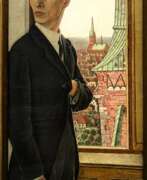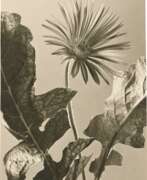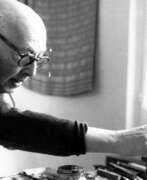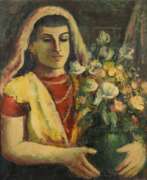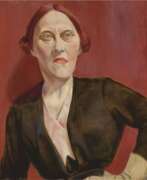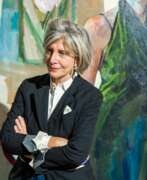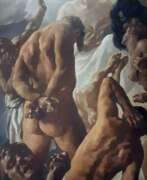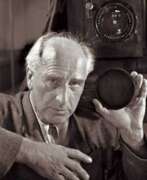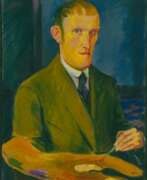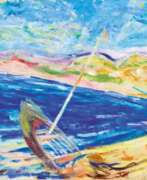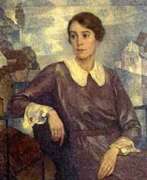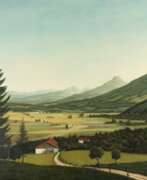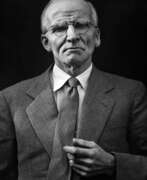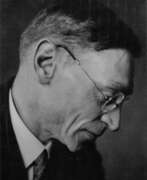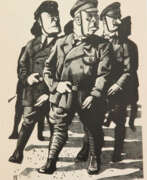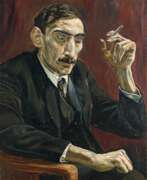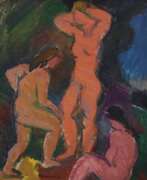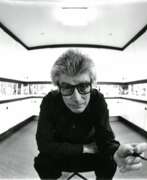New Objectivity
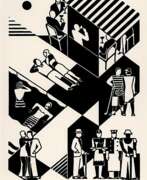

Gerd Arntz was a 20th-century German artist known for his skillful woodcut prints. A member of the Cologne Progressives—a group concerned not just with social and political issues, but also with the public’s ability to understand these concepts—Arntz sought to use his art as a method of delivering crucial information to the masses. Over the course of his life, he designed approximately 4,000 pictograms known as ISOTYPEs, or International System of Typographic Picture Education, a unique form of symbolized data from industries, politics, and economic phenomena intended for use by those who could not read.
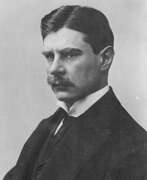

Hans Baluschek, full name Alphons Anton Alexander Hans Ernst Karl Maria Baluschek, was a German painter, graphic artist and writer, representative of the New Materiality style.
Baluschek studied at the Royal Academy of Arts, and in 1900 became a member of the Berlin Secession, a group of artists that also included Ernst Barlach, Max Beckmann, and Wassily Kandinsky. Baluschek was always socially critical, which was reflected in the subjects of his paintings. Many of his paintings are dedicated to the working class of Berlin, he addressed the gray everyday life of Berlin: gray air, gray walls, gray people. Baluschek is often categorized as a German Expressionist because of his emotional style, but his style has something of New Objectivity, Impressionism, and naive painting. He also drew illustrations for the popular children's book Little Peter's Trip to the Moon, and collaborated with periodicals as an illustrator.
World War I instilled patriotic feelings in Baluschek, and he painted a number of subjects on this theme. After the war, he joined the Social Democratic Party and became involved in labor movements. In 1926 he helped establish an artists' relief fund and later became director of the annual Berlin Exhibition. The German Nazis, who came to power in 1933, declared Baluschek a Marxist and a "degenerate artist," suspended him from all positions, and banned him from exhibiting.
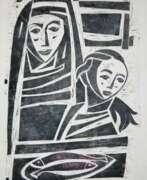

Carl Josef Barth was a German painter and graphic artist.
At the beginning of his artistic career Barth worked in the style of late expressionism, and later his works were attributed to the new objectivity and magical realism. Throughout his life, Barth changed from one style of painting to another. After World War II, the artist focused mainly on pessimistic subjects, ruins and hopelessness.
Carl Josef Barth's brother was the writer Emil Barth.
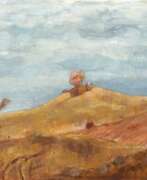

Siegfried Berndt, born 1880 in Germany and passing away in 1946, was a distinguished painter and printmaker whose artistic contributions are often overlooked in art history. After studying at the Dresden Art Academy, Berndt received a travel scholarship that profoundly influenced his art, taking him to cities like Paris, Brussels, Antwerp, London, and Scotland. These travels exposed him to diverse artistic movements, enriching his work with elements of Impressionism, Expressionism, and New Objectivity.
Berndt was especially skilled in the traditional Japanese woodblock printmaking technique, which he employed to explore various artistic styles. This unique approach resulted in color woodcuts with a distinct personality, appealing to a wide range of collectors. His woodblock prints are particularly noted for their innovative use of this traditional technique, blending it with Western artistic movements.
Despite the challenges posed by the two World Wars, Berndt's work found its way into public collections and was recognized for its artistic merit. However, much of his pictorial work was lost due to the turmoil of war. Some of his expressive pastel works, often repeated with small variations, as well as oil paintings, have been documented.
Berndt's art remains relevant for collectors, auctioneers, and experts in art and antiques, particularly for those interested in the intersection of Eastern and Western printmaking techniques. His work, although not as widely known, represents a unique blend of styles and techniques that contribute to the rich tapestry of early 20th-century art.
For enthusiasts interested in staying updated about sales and auction events related to Siegfried Berndt's work, subscribing to updates would be beneficial. This ensures access to the latest information about new sales and auction events related to his art.
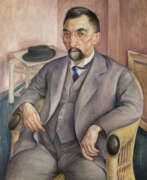

Albert Birkle was a German and Austrian painter, decorator, muralist and glass painter.
Albert's father was the artist Karl Birkle, from whom he received his initial training as a decorative painter, then studied at the Hochschule für die bildenden Künste (now the Berlin University of the Arts). Birkle developed a unique style based on Expressionism and the New Objectivity/Neue Sachlichkeit style. His subjects were lonely, mystical landscapes, typical scenes of Berlin in the 20s and 30s, portraits and religious scenes.
In 1932, fleeing the National Socialists, Albert Birkle moved to Salzburg, Austria, but nevertheless represented Germany at the Venice Biennale as early as 1936. In 1937, his work was declared "degenerate" in Germany and withdrawn from state collections. In 1946, Birkle was granted Austrian citizenship and began working on religious frescoes and decorative windows for various churches and oil paintings. The 1950s and 60s were filled with intense creativity in glass painting.


Volker Böhringer was a German painter and graphic artist.
He was a significant representative of the "New Objectivity. In his paintings and graphics Böhringer turned to socially critical representational themes, the theme of his early works being industrial landscapes. Böhringer refused to join the League of German Artists (VBKD), so he was forbidden to exhibit his work. Despite his secluded life, he received critical acclaim, and his work was shown in major public exhibitions of German modern art at the Art Museum Basel in 1937 and in Zurich in 1949. In the 1950s he increasingly turned to religious themes in his paintings.
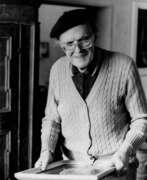

Albert Burkart was a German painter. His artistic work was based on the style of the New Objectivity around 1925. Burkart began working as a freelance painter in Munich in 1925. In the following years he created pictures and graphic sheets for the annual exhibitions in Munich and the galleries Heinemann and Tannhäuser. He also worked for Munich publishers, including the magazine Die Jugend. The Bavarian state and the city of Munich bought several of his works. He painted and drew industrial landscapes, workers, suburbs, old people and children in the big city before starting to create religious paintings, frescoes and stained glass windows and work for churches. One of his first religious works was the monumental painting of the choir of the Church of St. Joseph in Memmingen. His paintings combine sacral depictions with rich narratives and an architectural conception of space. Albert Burkart was a member of the artists' association "7 Munich painters". The association existed between 1930 and 1937.


Harry Callahan was an American photographer and artist who is best known for his innovative and experimental work in the mid-20th century. He was began his artistic career as a painter before turning to photography.
Callahan's photographic work was characterized by his interest in abstraction, pattern, and form. He often photographed everyday objects and scenes, such as street signs, buildings, and landscapes, and used his camera to explore the beauty and complexity of the world around him.
Callahan was also known for his work as a teacher, and he taught photography at the Rhode Island School of Design for many years. His students included notable photographers such as Aaron Siskind and Ray K. Metzker, and he was known for his rigorous and challenging approach to teaching.
Callahan's legacy as an artist and photographer continues to influence contemporary photography and art. His innovative techniques and distinctive style continue to inspire new generations of artists, and his work is recognized as a significant contribution to the history of photography.
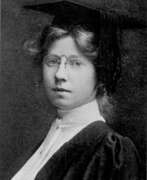

Imogen Cunningham was an American photographer known for her botanical photography, nudes, and industrial landscapes. Cunningham was a member of the California-based Group f/64, known for its dedication to the sharp-focus rendition of simple subjects.


Heinrich Maria Davringhausen was a German painter associated with the New Objectivity. Davringhausen was born in Aachen. Mostly self-taught as a painter, he began as a sculptor, studying briefly at the Düsseldorf Academy of Arts before participating in a group exhibition at Alfred Flechtheim's gallery in 1914. He also traveled to Ascona with his friend the painter Carlo Mense that year. At this early stage his paintings were influenced by the expressionists, especially August Macke.
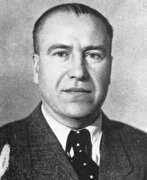

Aleksandr Aleksandrovich Deyneka (Russian: Алекса́ндр Алекса́ндрович Дейне́ка) was a Soviet Russian artist, celebrated for his significant contribution to the world of modernist figurative painting in the first half of the 20th century. Born into a Ukrainian origin, Deyneka's artistry spanned painting, graphic design, and sculpture, leaving an indelible mark on Russian modernism. His works, characterized by vivid movement and an innovative portrayal of the Soviet lifestyle, include iconic pieces such as "The Defense of Sevastopol," "Collective Farmer on a Bicycle," and "Future Pilots," which showcase the dynamism and spirit of the Soviet era. Deyneka's commitment to Social Realism—a style aimed at the accessible portrayal of everyday life—earned him both national and international acclaim. His murals and mosaics for public buildings and metro stations in Moscow, like the Mayakovskaya station, underline his influence on the Soviet visual landscape and contribute to his legacy as a pioneer of a style that bridged European innovation with Soviet themes.
Deyneka's journey began with his education at the VHUTEMAS, where he was influenced by figures such as Mayakovsky, which shaped his approach to art as a tool for societal influence and expression. His artworks, permeated with themes of labor, sports, and a forward-looking optimism, reflect the Soviet Union's utopian ambitions and the complexities of its societal structure. Notably, Deyneka's "Mother" stands out as a powerful symbol of the Soviet woman, intertwining high social awareness with the natural role of motherhood, highlighting the artist's nuanced approach to depicting Soviet life.
Throughout his career, Deyneka remained a formidable figure in art, navigating through various artistic societies and contributing to magazines and posters that defined the visual narrative of the Soviet Union. His travels to Italy, France, and the US broadened his perspective, enriching his work with international influences while retaining his distinct stylistic identity. Deyneka's decorations for the Moscow Metro not only won prestigious awards but also immortalized his vision of Soviet progress and optimism, capturing the essence of an era poised between grand aspirations and complex realities.
For art collectors and enthusiasts of Russian modernism, Deyneka's works offer a window into the vibrancy and ideological fervor of the Soviet Union, embodying the era's aesthetic and thematic aspirations. His contributions to the public and artistic spheres underscore the role of art in shaping and reflecting societal values, making his oeuvre a vital point of study for anyone interested in the intersections of art, history, and society.
To stay informed about exhibitions and auctions featuring Aleksandr Aleksandrovich Deyneka's work, sign up for updates. This subscription ensures you're always in the know about new sales and events related to this iconic artist, allowing you to deepen your appreciation and possibly enhance your collection.
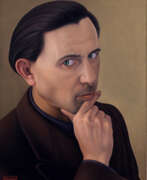

Cagnaccio di San Pietro, real name Natale Bentivoglio Scarpa, Italian painter of magical realism. He studied painting at the Academy of Fine Arts in Venice.
Cagnaccio di San Pietro in the beginning of his creative activity devoted to salon painting, was fond of futurism, then worked for a long time as a representative of the Italian variant of the New Realism. His work is characterised by portraits, nudes, still lifes, paintings of religious content and domestic subjects.
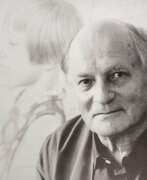

Rudolf Dischinger is a German artist, representative of the “new materiality” movement. Studied at the State School of Art in Karlsruhe (Baden). He took part in the exhibition “Newest Ways of Painting and Drawing” in Leipzig. He taught at the women's real school in Freiburg. With the outbreak of World War II, he was sent to the front as a soldier. He fought in France and the USSR. After being wounded in 1942, he returned to his homeland. He taught at the State Academy of Arts in Freiburg. After the abolition of the academy, he taught at the Goethe Gymnasium there. Awarded the Reinhold Schneider Prize from the city of Freiburg. Until the beginning of World War II (1939), he painted mainly city landscapes and still lifes in the style of “new materiality.” After 1945 he turned to abstract art. In the last years of his life he again worked in object painting.


August Wilhelm Dressler was a German artist and proponent of the New Objectivity.
Dressler studied at the Dresden Art Academy, then at the Academy of Graphic Arts and Book Trade in Leipzig. In Berlin, he joined the November Group and in 1924 became a member of the Berlin Secession. From 1934, Dressler taught at the Berlin State School, from which he was expelled in 1938 as a "degenerate artist". In 1937, during the Nazi "Degenerate Art" campaign, Dresler's works were confiscated and many were lost.
After World War II, the artist resumed exhibitions in Berlin, and in 1956 was offered a teaching position at the Higher School of Applied Arts in West Berlin. Dressler left behind an extensive body of work in painting and drawing, of particular importance are his numerous portraits and depictions of women.


Teo Eble was a Swiss abstractionist painter and graphic designer.
Eble studied at the Academy of Fine Arts in Berlin, then taught at the Basel School of Applied Arts from 1931 to 1967. In 1933 he co-founded the Swiss Group 33, an anti-fascist association of artists.
His work was influenced by the realist, objective painting of the 1920s. The subjects of Eblé's early works were landscape paintings and depictions of cities and their life.
In 1934, Eblé began abstract painting and became a prominent artist of the abstract movement in Switzerland and was also recognized internationally. He held exhibitions in France and the United States, in 1958 at the Venice Biennale and in 1959 at Documenta in Kassel. In the 1960s, Eblé created numerous murals in public buildings.
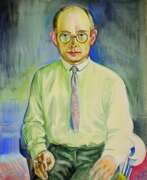

Alois Erbach was a German graphic artist and painter.
In his painterly works, Erbach was initially oriented towards Expressionism. Later works show influences of Surrealism and New Objectivity.
Erbach was at least close to the KPD and was a member of the Association of Revolutionary Visual Artists ASSO, the Red Group and the group "Die Zeitgemäßen" Under the pseudonym "Aleus" or "Marc Aleus", Erbach supplied caricatures for the Rote Fahne and the satirical magazines Knüppel, Die Pleite and Eulenspiegel.
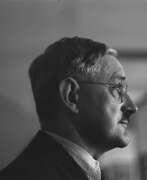

Conrad Felixmüller was a twentieth-century German artist, born Conrad Felix Müller. He is known as a painter, graphic artist, illustrator and printmaker, a representative of the New Materiality movement, who worked in the Expressionist style.
Felixmüller created about 2,500 paintings and graphic drawings, the main motif of which was the human being. The artist considered himself a socially critical expressionist, and his works reflected scenes from everyday life. In the 1930s, many of his works were confiscated by the Nazis as examples of degenerate art and destroyed. As a result of the bombing of Berlin in 1944, Felixmüller lost much of his work.


Hans Finsler was a Swiss and German master of photography, a representative of the New Objectivity artistic movement.
He studied art history and architecture, but then was introduced to photography and became interested in it.
In 1927 he volunteered at the New Photographic Society in Berlin. In 1929 his participation in the exhibition "Film and Photography" in Stuttgart brought Finsler fame. He founded the photographic department of the Kunst Geverbeschule in Zurich, where many photographers who later also became famous studied. From 1946 to 1955 Finsler was president of the Swiss Union of Artists.
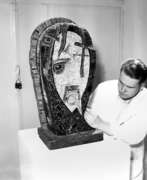

Ludwig Gies was a German painter. He was best known for his paintings and prints, which were influenced by Expressionism and the New Objectivity movement.
Gies studied at the Academy of Fine Arts in Munich and then at the Kunstgeverbeschule in Berlin. In the 1920s he became a member of the 'November Group', a group of artists who sought to create a new form of art that was politically engaged and socially relevant. Gies was also a member of the Association of Revolutionary Visual Artists of Germany.
In his work, Gies often depicted working class people, urban scenes and still life subjects with a sense of social realism. His style was characterized by bold lines, vivid colours and dynamic composition, which gave his works a powerful emotional impact.
Gies's art was widely exhibited in Germany during his lifetime and he was awarded several prizes and awards for his work. Today, his paintings and prints are in the collections of many museums and galleries in Germany and abroad.


Otto Griebel was a German artist of the twentieth century. He is known as a painter and graphic artist who worked in the directions of "new subject matter" and socialist realism.
Griebel joined the Dadaists after World War I and was a member of the Dresden Dadaist group. He participated in various artistic associations, including the Dresden Secession Group, the Aktion group of artists, the Association of Free Artists of Saxony, and others. In 1933, the artist was arrested by the Gestapo and his work was recognized as "degenerate art". Most of the master's work was lost during the bombing of Dresden in 1945.
Griebel was also a talented puppet theater artist and created sets for puppet shows.
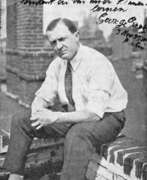

George Grosz was a twentieth-century German painter, graphic artist, and cartoonist. In his work one can find features of various styles of avant-garde art, including Dadaism, Expressionism, and Futurism.
George Grosz drew in every style in a sharp-grotesque and satirical spirit, ridiculing the vices of society. The erotic theme, which occupied a prominent place in Gross's work, was executed in the same spirit.
Grosz devoted more than 20 years to teaching at the Art Students League of New York, and was elected an honorary member of the American and Berlin Academies for his outstanding services to the arts.
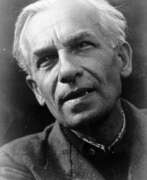

Hans Grundig was a German artist of the first half of the twentieth century. He is known as a painter, graphic artist and teacher, professor and rector of the High School of Fine Arts in Dresden, and husband of the artist Lea Grundig.
Grundig produced works that stylistically belong to the "new materiality" and revolutionary-proletarian realism. In 1932 he visited the USSR, where he participated in the exhibition "Revolutionary Art in Capitalist Countries" in Moscow. His art during this period was strongly anti-fascist, the works were created in a realistic-expressive style. After the Nazis came to power, he was banned from painting and his works were recognized as "degenerate art". The artist was arrested and sent to the Sachsenhausen concentration camp.
Grundig's paintings today are an important part of the golden fund of realist art in twentieth-century Germany.


Ulrich Hachulla is a German painter and graphic artist, representative of the New Objectivity movement, who lives and works in Leipzig.
He was educated at the Academy of Fine Arts in Leipzig and, in addition to painting, has mastered many graphic techniques.
Hahulla's portraits and self-portraits depict a man in solitude, unsociable, coldly detached - these are numerous types of the respective times. The artist also creates paintings with mythological and allegorical references.


Elsa Haensgen-Dingkuhn is a German artist and graphic artist of the New Objectivity movement.
Elsa Haensgen studied first at the Flensburg Art School, then attended the Hamburg School of Arts and Crafts as the first female student. She married the artist Fritz A. Dingkuhn and soon began participating in numerous solo and group exhibitions, including the Hamburg Secession, with great success. In 1933 Elsa Haensgen-Dingkuhn joined the Hamburg Artists' Association.
Together with her husband, the artist traveled extensively and painted landscapes, genre scenes, portraits and self-portraits, but a special place in her work is occupied by the theme of family and children.
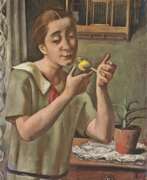

Wilhelm Heise was a German painter associated with the New Objectivity. He earned a living by painting clocks, for which he developed a meticulous technique. In 1925, he participated in the Neue Sachlichkeit (New Objectivity) exhibition in Mannheim which brought together many leading "post-expressionist" artists, including George Grosz, Otto Dix, Max Beckmann, and Georg Scholz. His painted self-portrait entitled Fading Spring is representative of his style. Heise won the Nuremberg Dürer Prize in 1937.
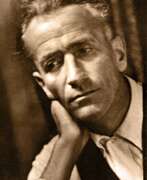

Louis Christian Hess was an Austrian painter and sculptor of the German Neue Sachlichkeit (New Objectivity) during the 1920s. In 1915 Hess exhibited his first works - drawings, tempera and engravings - at the "Turn und Taxishof Galerie" in Innsbruck. After the war, from 1919 to 1924 he attended the Bayerische Akademie der Bildenden Künste in Munich, in the class of Prof. C. Becker-Gundhal. In 1920 Hess attended the first collective exhibition "Ausstellung Junger Münchner - Graphische Kunstwerkstätten" in Munich presented by George Jacob Wolf. In 1928 he became close to Max Beckmann until his exile. Hess participated in the "Sommer Ausstellung des Deutschen Künstler Verbandes AUFBAU - E. V." in Munich and some of his paintings were shown in Berlin. In 1929 he joined the "Juryfreie" movement, becoming its leader until his ban in 1933 by the National Socialist regime. The artistic ostracism practised by Nazism moved Hess to a voluntary exile.


Gussy Erika Edith Hippold-Ahnert, née Ahnert, was a German painter and master student of Otto Dix. The early work of the Dix student, such as the painting Lying Nude from 1931, shows her closeness to Dix's New Objectivity or Verism. She reached her artistic peak in 1932/1933, when she developed a painting style of her own, unmistakable character in the glazing technique taught by Dix. Hippold-Ahnert's late work is closely connected to the works of her husband Erhard Hippold and other artists of this region and time.


Heinrich Hoerle was a notable German artist, distinguished for his contributions to the constructivist movement and the New Objectivity movement. Born in Cologne, Heinrich Hoerle was largely self-taught, developing a unique style after his experiences in World War I and his involvement in the Cologne Dada scene. His works often depicted generic figures in rigid poses or profiles, reflecting his influences from Russian constructivism, French cubism, and the Dutch De Stijl movement. Hoerle co-founded the artist group Stupid and published influential series like the Krüppelmappe (Cripples Portfolio), exploring themes of disability and war's human toll.
His art, which includes pieces like "Denkmal der unbekannten Prothesen," is preserved in various public collections, including Museum Ludwig in Cologne and the Von der Heydt Museum in Wuppertal. Despite facing condemnation by the Nazis, Hoerle's legacy endures through his thought-provoking works that continue to be celebrated and discussed in academic circles, as evidenced by events like the gallery talk at Harvard Art Museums focusing on his Cripple Portfolio series.
For collectors and art enthusiasts, understanding Heinrich Hoerle's impact on modern art provides a valuable perspective on the interplay between art, society, and history. If you're keen on delving deeper into Heinrich Hoerle's artistic journey and wish to stay updated on related auctions and exhibitions, consider subscribing for updates on new product sales and auction events pertaining to his works.
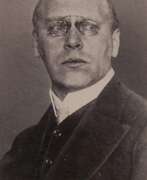

Ludwig von Hofmann is a German painter, graphic artist and designer. The influence of Historicism, Art Nouveau, Symbolism and New Realism can be felt in the works of Ludwig von Hofmann at different periods of his art.
Ludwig von Hoffmann studied painting at the academies of fine arts in Dresden, Karlsruhe and Munich. Since 1898 he was a member of the cultural movement Berlin Secession.
After the National Socialists came to power in Germany, some of his works were classified as degenerate art, but most of them continued to be exhibited in museums in Germany.


Alexander Kanoldt was a German painter of the first half of the twentieth century. He is known as a painter, landscape and portrait painter, a representative of the New Materiality movement.
Alexander Kanoldt was one of the founders of the New Munich Art Association and the Blue Rider group. His style evolved from Neo-Impressionism to magic realism, to depicting plants, objects, landscapes and people in angular forms. During the Nazi regime, he tried to adapt to the styles in demand, but many of his works were confiscated as belonging to "degenerate art."
Kanoldt was a professor at the Berlin Academy of Art and director of the State School of Art in Berlin until his retirement in 1936.


Franz Klemmer was a German painter. After leaving school, Klemmer began an apprenticeship as a church painter and, after completing his training in 1905, switched to the Munich School of Applied Arts. At the beginning of the First World War, Klemmer joined a Bavarian foot artillery regiment in 1914. Even during the war years, sketches and drawings were made that attracted a great deal of attention. After the war, Klemmer returned to Munich, where he opened his own studio and began collaborating with Carl Johann Becker-Gundahl, a professor of monumental painting at the Academy of Fine Arts in Munich. Here Klemmer turned to fresco painting and received a teaching position at the Academy of Arts. In 1926, after the death of Becker-Gundahl, Klemmer was appointed his successor and received a chair in ecclesiastical painting.


Volker Köpp was a German painter.
He studied at the Academy of Fine Arts in Dresden and initially worked as a prop master in the theater. Köpp takes on all the classical thematic areas of painting: nudes and portraits, group portraits, still lifes, houses and streets, landscapes are depicted powerfully and sensually, with strong colors or with a muted palette.


Lotte Laserstein was a German-Swedish artist and a prominent representative of German realism.
Lotte was a student at the prestigious Berlin Academy of Fine Arts and became an accomplished realist painter, receiving a gold medal from the Academy for her work. Her first exhibition took place in 1930 at a Berlin gallery. Laserstein worked partly in figurative painting, had apprentices, and illustrated anatomy texts to earn money. She also painted portraits of cosmopolitan, emancipated women as well as self-portraits.
The National Socialist regime forced the artist to leave Germany in 1937 and emigrate to Sweden. Her mother died in a concentration camp. Lotte Laserstein lived in Stockholm until the end of her life, creating over five decades of work, in addition to expressive self-portraits, many moving images of other immigrants, rural landscapes and urban scenes in Sweden.
Lotte Laserstein became a member of the Swedish Academy of Fine Arts and earned a reputation as a popular and respected portraitist. She has approximately 10,000 works in her oeuvre.
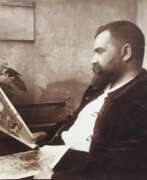

Emil Maetzel was a German architect, painter, graphic artist and sculptor.
In 1919, Maetzel was a co-founder of the Hamburg Secession, an organisation promoting modern art in northern Germany. He was also a member of the November Group, an association of expressionist artists in Berlin.
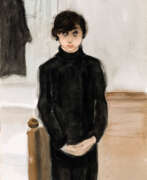

Jeanne Mammen was a twentieth-century German artist. She is known as a graphic artist and draftsman, a representative of modernism, a prominent figure in the artistic life of the Weimar Republic.
Jeanne Mammen developed an artistic style close to the New Materialism school. As she grew older, her work became more symbolic; after 1945, the artist moved towards abstractionism. She worked for fashion magazines, created movie posters, and illustrated erotic poetry. Mammen actively developed collage techniques, as well as creating portraits and caricatures, and sketching street types.
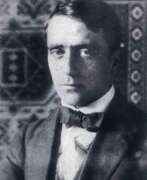

Carlo Mense was a German artist of the twentieth century. He is known as a painter and graphic artist, a representative of Rhenish Expressionism and New Materialism.
Mense was a member of artists' associations such as the Cologne Secession, Gereon Club, Young Rhine, and November. He actively participated in Expressionist exhibitions. Creating graphic works for the magazines "Action" and "Sturm", he became known for his artistic style. In 1937, the Nazis destroyed 37 of his works, categorizing them as "degenerate art." Mense left a significant mark on twentieth-century German painting with his expressive and evocative works.


Hanna Nagel, a German illustrator, painter, and draughtswoman, was recognized for her critical examination of gender roles and societal norms, particularly focusing on the experiences and representation of women. Hanna Nagel's early works were marked by a patriarchal critique, delving into issues of discrimination and societal conditions faced by women. She studied at the Badische Landeskunstschule Karlsruhe and later at the Vereinigte Staatsschulen für Freie und Angewandte Kunst in Berlin under the guidance of Emil Orlik.
Hanna Nagel's art often featured the female figure, exploring themes of dependency, power dynamics, and the complex roles of women in society. Her style evolved from sharp caricature to a more nuanced and dreamlike representation, with works like "Woman in Blue Dress" exhibited at The Metropolitan Museum of Art reflecting this transition. Throughout her career, she also contributed significantly to book illustration, adding depth to literary works with her expressive visuals.
Hanna Nagel's legacy is preserved through her contributions to German art and culture, with her works displayed in exhibitions and held in collections worldwide. She remains a pivotal figure in the exploration of feminist themes in art, offering a unique perspective on the interplay between gender, identity, and societal expectations.
For those interested in exploring the depth and range of Hanna Nagel's work, consider signing up for updates on exhibitions, sales, and auctions related to her artwork. This subscription will provide insights into available pieces and events celebrating her contributions to art and culture.
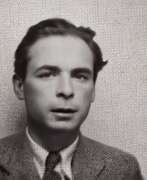

Felix Nussbaum was a German artist of the first half of the twentieth century of Jewish origin. He is known as a painter and graphic artist, representative of the artistic style "New Objectivity".
Felix Nussbaum in 1934, fleeing Nazism, emigrated to Belgium. In 1936, together with his friend Michael Loewen, he conceived the idea of creating a children's animated film "Pete and Peggs", which was never realized, but his black-and-white drawings were preserved. Nussbaum created his major works in the last years of his life, spent in Brussels before his arrest in 1944. In his works, the artist artist artistically and with rare expressiveness depicted the Nazi persecution and murder of Jews in Europe. He himself died in the Auschwitz concentration camp six months before its liberation by Soviet troops.
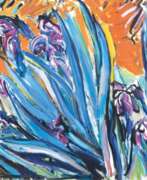

Wilhelm Ohm, full name Wilhelm Friedrich Hubert Ohm, was a German painter, draftsman, sculptor and architect.
Ohm trained in architecture and worked as a government architect and engineer, and studied sculpture and mural painting at the Prussian Academy of Fine Arts in Berlin. From 1923 to 1933 he was a member of the North German Artists' Association. In 1940 Wilhelm Ohm received a Bachelor's degree from the Technical University of Berlin on the colorful redesign of cities, through which he wanted to combine painting and architecture into a unified whole. This idea occupied him throughout his life.
Wilhelm Ohm's work of the 1920s can be stylistically categorized as New Objectivity and Surrealism. After World War II, trying to make up for lost time, he saturates his paintings with color and energy. His later works were done in a post-impressionist style. This applies to his landscapes, nature studies, floral bouquets and fruit compositions.
Wilhelm Ohm's son August Ohm, born in 1943, also became an artist.


Sergius Pauser, an Austrian painter, gained international recognition in the 1930s, receiving prestigious awards such as the Carnegie Exhibition Prize in Pittsburgh. After studying architecture, he switched to painting and was influenced by Max Beckmann, Otto Dix, and Karl Hofer. However, his career was halted by the Nazi regime. Adolf Hitler personally tore down Pauser's paintings, deeming them degenerate art. Pauser was banned from exhibiting and labeled politically unreliable. He ended up in a concentration camp but was later rehabilitated and reinstated as a teacher at the Academy of Fine Arts in Vienna. Despite controversy, he painted the official picture commemorating Austria's sovereignty.
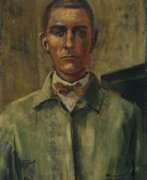

Anton Räderscheidt was a German painter who was a leading figure of the New Objectivity. Räderscheidt was born in Cologne. His father was a schoolmaster who also wrote poetry. From 1910 to 1914, Räderscheidt studied at the Academy of Düsseldorf. He was severely wounded in the First World War, during which he fought at Verdun. After the war he returned to Cologne, where in 1919 he cofounded the artists' group Stupid with other members of the local constructivist and Dada scene. The group was short-lived, as Räderscheidt was by 1920 abandoning constructivism for a magic realist style. In 1925 he participated in the Neue Sachlichkeit ("New Objectivity") exhibition at the Mannheim Kunsthalle.
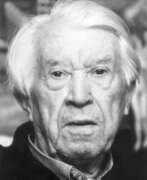

Franz Radziwill was a German artist of the twentieth century. He is known as a landscape painter, graphic artist and printmaker associated with the artistic movement of "new materiality".
Franz Radziwill created paintings that are characterized by careful elaboration and the use of glaze techniques borrowed from the Old Masters. He used elements of industrial buildings and modern technology, including ships and airplanes, in his landscapes. The results of his work can be categorized as magical realism.
In 1933 Radziwill became professor of painting at the Düsseldorf Academy of Art, but in 1935 the Nazis stripped him of this position, declaring his work degenerate art.


Otto Rodewald is a German painter and graphic designer.
Rodewald studied at the Hamburg State Art School and participated in exhibitions. Rodewald traveled extensively, mostly in Europe and the Middle East; between 1929 and 1931 he lived in the Tunisian artists' village of Sidi Bou Said, where he was captivated by Eastern exoticism. His style can be categorized as magical realism and new objectivity. He also painted portraits in the Neo-Saxon style.
Otto Rodewald later co-founded the art club Die Insel and from 1928, after participating in several exhibitions, became a permanent member of the Hamburg Secession and a member of the Hamburg Artists' Association.
During the National Socialists' campaign against degenerate art in 1933, some of Rodewald's works were banned, but in order to survive, the artist continued to work with Hitler's government, fulfilling their commissions. After the end of World War II, the artist remained active until his death.


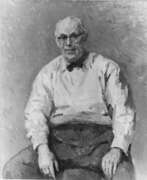

Wilhelm Rudolph was a German painter, graphic artist and teacher.
Rudolph studied at the Dresden Art School, fought in World War I and returned to art. He went from Post-Impressionism to Expressionism and later became a follower of the New Objectivity with a bias towards socially relevant subject matter. Rudolph's first successes and fame came from his graphic depictions of animals.
In 1932, Wilhelm Rudolph was appointed a professor at the Dresden Academy of Art, but with the National Socialists coming to power in Germany, the artist's works were classified as so-called degenerate art. Since 1937 he was forbidden to exhibit and sell his works, 43 of his paintings were confiscated, and in 1939 he was dismissed from the Academy.
At the end of the war, the artist created his major work - an extensive graphic series of 150 sheets on the theme of the bombing of Dresden by American aircraft on the night of February 13-14, 1945, as a result of which the city was completely destroyed. This essential work remains an unrivaled artistic record of that tragedy. Wilhelm Rudolph was a two-time winner of the GDR National Prize and worked actively until his old age.
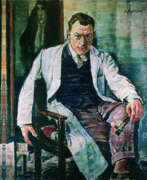

Nikolaus Sagrekow (Russian: Николай Александрович Загреков) was a Russian and German artist of the twentieth century. He is known as a painter, a representative of the "new materiality" movement, and also as an architect.
Nikolaus Sagrekow moved to Germany with his German wife in 1921 and remained there for the rest of his life. He taught portrait painting and nudes. In the late 1920s and early 1930s, the artist reached the peak of his creativity. He participated in many exhibitions in Berlin, Munich, Paris and Vienna. In 1952, the master received German citizenship and became deputy chairman of the Union of Berlin Artists. From the mid-1930s he began to engage in architectural work, and in 1960-1970 he created many paintings, including portraits of German political figures.


Christian Schad was a German painter and photographer. He was associated with the Dada and the New Objectivity movements. Considered as a group, Schad's portraits form an extraordinary record of life in Vienna and Berlin in the years following World War I.


Josef Scharl is a German and American painter, illustrator, and graphic designer.
Scharl trained as a decorative painter at the Munich Art School, where he also gained practical experience in painting restoration. He was wounded in the war, and after returning to Munich, he continued his studies at the Kunstakademie. In the 1920s Josef Scharl joined the artist groups New Munich Secession and Juryfreien, successfully participated in their exhibitions, and later became acquainted with the Impressionists.
Writing in the New Objectivity style, Josef Scharl was forced to emigrate to the United States in 1939, and 1944-46 marked the peak of his fame in the United States. He was also commissioned by the publisher Pantheon Books to illustrate the Grimm brothers' fairy tales and other books.
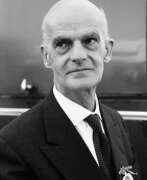

Wilhelm Schnarrenberger was a German painter and representative of the New Objectivity movement.
Schnarrenberger studied graphics at the Munich School of Applied Arts, as well as architecture. After his studies, the artist received commissions for publications in the magazines Das Plakat or Simplicissimus as well as numerous illustrations for publishing houses. At the same time, Schnarrenberger also began to work as a painter and participated in the exhibitions of the New Munich Secession. After the Expressionist phase, his painting was replaced by an increasingly distinct style, which in 1925 became known as Neue Sachlichkeit ("New Objectivity"). In 1920, the artist was appointed to teach commercial art at the Badisches Landeschool in Karlsruhe, where he later became a professor.
As a result of the Nazis' rise to power, Schnarrenberger lost his professorship and moved to Berlin. In 1937, Wilhelm Schnarrenberger's paintings were recognized as degenerate and he was persecuted. After the end of the war, he was allowed to resume his professorship and was appointed professor at the Karlsruhe State Academy of Fine Arts. He became a member of the Badische Secession and received the Hans Thom State Prize in 1962.
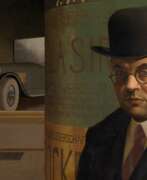

Georg Scholz is a German painter and a vivid representative of the New Objectivity movement.
Scholz studied painting at the Karlsruhe Academy of Fine Arts and continued his studies in Berlin with Lovis Korint. After serving in the army in World War I from 1915 to 1918, he returned to painting in the style of Cubism and Futurism. Scholz's entry into the German Communist Party is reflected in his paintings, which sharply and sarcastically criticize the social and economic order of post-war Germany.
Georg Scholz very soon became one of the leaders of the New Realism, a group of artists who practiced the most cynical form of realism. In 1925 he received a professorship at the State Academy of Art in Karlsruhe. In 1926 he began collaborating with the satirical magazine Simplicissimus, and in 1928 he visited Paris.
After Hitler and the National Socialists came to power in Germany in 1933, Scholz immediately lost his teaching job. His work was declared degenerate art, his works were withdrawn from collections in 1937, and the artist himself was banned from painting in 1939.


Georg Gerhard Schrimpf was a German self-taught painter and graphic artist, one of the greatest representatives of the New Objectivity movement.
Earning a living as a baker, waiter and so on, Georg constantly painted and perfected this skill. In 1915, Schrimpf moved to Berlin, where he first worked in a chocolate factory. He soon attracted the attention of the art historian, gallerist and publicist Gerwart Walden, who successfully exhibited Schrimpf's first oil paintings. He also created woodcuts for magazines. In 1920, Schrimpf exhibited for the first time at the New Secession exhibition at the Glass Palace in Munich, and a year later became a member of this group.
The motifs of Schrimpf's works were often women in melancholy moods, and his landscapes are of desolate, pure nature.
From 1926 to 1933 Schrimpf taught at the Munich School of Applied Arts, in 1933 he was appointed assistant professor at the Royal Art School in Berlin, and then the Nazi regime that came to power in Germany declared the artist's work degenerate, and 33 of Schrimpf's works were withdrawn from German museums. By the end of 1937, Georg Schrimpf was relieved of his teaching position in Berlin and died of heart failure a few months later at the age of 49.
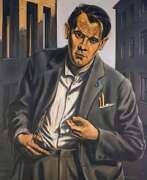

Walter Schulz-Matan was a German painter of magic realism. After training as a decorative painter, the Thuringian Walter Schulz-Matan led a life of wanderings across Europe. After military service and captivity in World War I, he lived in Munich from 1919, maintained his first studio in Munich-Schwabing from 1920 and worked as a stage painter for the "Neue Bühne". From 1930 he was one of the co-founders of the exhibition group 7 Munich painters. Schulz-Matan was also a member of the Neue Secession and the Deutscher Künstlerbund. In the New Objectivity art movement, Schulz-Matan developed his own artistic specificity in the Magic Realism movement. During the Second World War he worked as a war painter in France, then again as an artist in Munich.
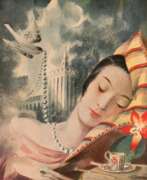

Max Schwarzer was a German commercial artist and illustrator. In 1914, together with Friedrich Heubner, Valentin Zietara, Emil Preetorius, Franz Paul Glass and Carl Moos, he founded the artists' association The Six, one of the first groups of artists to market advertising commissions. Max Schwarzer drew for the satirical journal Simplicissimus. His carnival posters shaped the Munich carnival, such as In the Magic Garden of Regina (Carnival 1928) or Munich Carnival (1934). Max Schwarzer painted covers for the magazine Uhu in the New Objectivity style. In 1930 he made the Art Deco mosaics on the steamer Europa with Hans Gött. In the early 1920s, he illustrated the fairy tale volumes for the Munich Rösl publishing house with hand-colored pictures and ornaments.


Richard Seewald was a German painter, graphic artist, illustrator and educator.
Seewald studied architecture at the Munich Polytechnic Institute, but soon turned to painting and collaborated with magazines that published his cartoons. He soon mastered etching and etching, became a member of the New Munich Secession in 1913, and illustrated an edition of Robinson Crusoe, Penthesilea (Heinrich von Kleist) and his first book.
In 1924 Seewald was appointed to a teaching position at the Werkschule in Cologne; in 1931 he settled in Ticino, where he received commissions for murals in churches and other church buildings. In 1954 Richard Seewald accepted an offer to become a professor at the Academy of Fine Arts in Munich, and resigned four years later after a disagreement with the academy's presidium. After his wife's death, he burned about 150 of his paintings, as well as hundreds of sketches, drafts, and correspondence. In the late 1960s, Seewald designed windows for the Herz-Jesu-Kirche (Sacred Heart Church) in Munich-Neuhausen and St. Michael's Church in Iserlo.
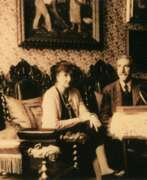

Max Stern was a German painter and graphic artist of Jewish ancestry, associated with the Düsseldorfer Malerschule. He was originally an Impressionist, but later became an advocate of the New Objectivity.
His career progressed uneventfully until the Nazi takeover in 1933. At that point, he was placed under a professional ban, and expelled from Malkasten. With the establishment of the Reichskulturkammer, it became difficult to obtain painting supplies. Despite this, he and his fellow Jewish artists in the Judische Kulturbund were able to exhibit among themselves until 1936. Shortly after that, in 1937, Joseph Goebbels ordered the confiscation of all "degenerate art", which included Stern's works.
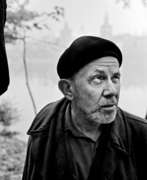

Josef Sudek was a Czech photographer known for his poetic images of Prague and its surroundings. He initially studied bookbinding before becoming interested in photography.
Sudek is known for his use of the large format camera, which allowed him to create highly detailed and nuanced images. He often photographed still lifes, landscapes, and architecture, but his most iconic images are his atmospheric images of Prague, which he captured over the course of several decades.
Sudek's photography is characterized by its emphasis on light, shadow, and texture, and his images often have a dreamlike or poetic quality. He also experimented with different printing techniques, including platinum printing, which gave his photographs a soft and velvety texture.
Despite facing numerous challenges throughout his life, including losing an arm in World War I and facing political persecution during the Communist regime in Czechoslovakia. Today, he is considered one of the most important photographers of the 20th century, and his work is held in major collections around the world, including the Museum of Modern Art in New York and the National Gallery in Prague.


Adolf Uzarski was a German writer, painter and illustrator.
Trained as an architect, Adolf also graduated from the Düsseldorf School of Arts and Crafts, and exhibited his first Art Nouveau paintings. During the First World War he painted posters and postcards with patriotic content, during these years his anti-war lithograph series "Dance of Death" was published. In 1919 Adolf Uzarski became one of the founders of the avant-garde artists' association "Young Rhineland" in Düsseldorf, he became interested in Expressionism and the current in art "New Materiality".
Uzarski always opposed militarism, nationalism and anti-Semitism, and his art was caricatured and sharply satirical of bourgeois society. With the advent of the National Socialists in Germany in 1933, Adolf Uzarski was persecuted. For many years he had to live semi-clandestinely, in 1942 the Nazis condemned him as a degenerate artist and forbade him to paint, forcing him to flee to Belgium. At the end of World War II, Uzarski returned to Düsseldorf and continued his career.
From 1919, Adolf Uzarski began writing satirical novels, publishing a total of 10 volumes, as well as children's picture books.
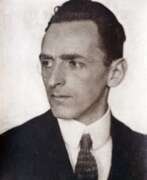

Evarist Adam Weber was a German painter, graphic artist, illustrator and craftsman.
After studying at the Düsseldorf Art Academy, Weber began his career with Impressionist landscape paintings influenced by Cézanne. Later he turned to Expressionism and created numerous series of woodcuts, which he exhibited as a member of the Young Rhineland and at exhibitions in Bavaria and Austria. In the 1920s, Evarist Adam Weber's graphic works, drawings and paintings increasingly combined Expressionist forms with New Objectivism motifs. He was a passionate motorcyclist and produced many paintings and graphic works on the theme of motorcycling.
In addition to painting and graphics, Weber was also active as a craftsman. In 1931, together with his second wife, Gertraud Heubach (1895-1962), he founded the art and craft workshops Weber-Heubach. Thereafter, they regularly participated in Leipzig's famous Grassi fairs, presenting leather and textile products, jewelry and carved glass.
Evarist Adam Weber belongs to the so-called lost generation of artists rediscovered in the 21st century.
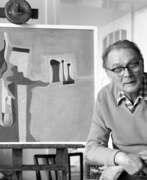

Erich Wegner was a German artist. His work was heavily influenced by the expressionist movement, and he often depicted scenes of daily life in a bold and expressive style.
Wegner's paintings were characterized by their thick brushstrokes and vibrant colors, which conveyed a sense of energy and movement. He often painted urban scenes, such as street scenes and cityscapes, and also produced numerous portraits and still-life compositions.
During the Nazi regime in Germany, Wegner's work was deemed "degenerate" and he was forbidden to exhibit his art. Despite this, he continued to work in secret and later resumed exhibiting his work after the war.
Today, Wegner's work is held in collections around the world, including the National Gallery in Berlin and the Museum of Modern Art in New York.
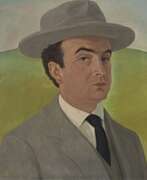

Gustav Wunderwald was a German painter and stage designer, a representative of the New Objectivity movement.
Wunderwald studied painting at the Cologne studio of Wilhelm Kuhn and worked as a designer in Gotha. Since 1912 Wunderwald served as a set designer at the Deutsche Oper in Berlin. As a painter Wunderwald created about 200 paintings in various genres.
